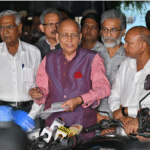V. Narayanan in a landmark moment for India’s space research and exploration journey, V. Narayanan has assumed the role of Chairman of the Indian Space Research Organisation (ISRO), succeeding the highly accomplished S. Somanath. Narayanan, a veteran scientist with decades of experience in rocket propulsion and satellite technology, brings a wealth of expertise and a visionary approach as he steps into the leadership of India’s premier space agency. As he takes the reins, Narayanan faces the challenge of continuing ISRO’s impressive legacy while steering the organization into an era of expanded exploration and commercial partnerships.
Narayanan’s appointment comes at a pivotal time for ISRO, following the remarkable successes of the Chandrayaan-3 mission and the launch of the Aditya-L1 solar mission. As India asserts itself as a dominant player in space research and exploration, Narayanan’s leadership will play a critical role in charting the agency’s course for the future. This article examines his remarkable career, the challenges and opportunities that lie ahead, and the legacy he inherits from his predecessor, S. Somanath.
The Career and Contributions of V. Narayanan
V. Narayanan is a distinguished scientist whose illustrious career has been intricately linked with ISRO’s major achievements in space exploration and satellite technology. With nearly four decades of service to the agency, he is widely regarded as a key contributor to India’s space program.
Expertise in Rocket Propulsion
Narayanan is known for his groundbreaking work in rocket propulsion systems, a cornerstone of modern space exploration. Over the years, he has served in various critical roles, including Director of the Liquid Propulsion Systems Centre (LPSC), ISRO’s hub for the development of liquid propulsion systems used in rockets and spacecraft. His work has contributed significantly to India’s development of high-thrust cryogenic engines, which are vital for launching heavier payloads into space.
As the Director of LPSC, Narayanan was instrumental in advancing ISRO’s cryogenic engine program, V. Narayanan which powers the Geosynchronous Satellite Launch Vehicle (GSLV). Under his guidance, India achieved self-reliance in cryogenic technology, breaking its dependence on foreign systems. The success of missions like GSLV-Mk III (also called LVM-3), V. Narayanan which carried out vital missions including Chandrayaan-2, Chandrayaan-3, and the ambitious Gaganyaan program, is a testament to his contributions.  For the more information click on this link
For the more information click on this link
Academic Achievements and Vision
Narayanan holds a postgraduate degree in engineering and has earned recognition for his academic contributions. His expertise in propulsion systems and project management has made him a respected figure within ISRO and among international space agencies. He has published several technical papers in propulsion technology, underlining his commitment to innovation and knowledge-sharing in the field of space science.
As ISRO continues to embrace ambitious goals, Narayanan’s vision is expected to revolve around building advanced propulsion technologies, deepening commercial partnerships, V. Narayanan and expanding India’s footprint in interplanetary exploration.
Succeeding S. Somanath: Big Shoes to Fill
V. Narayanan succeeds S. Somanath, who led ISRO through one of the most transformative periods in its history. Appointed ISRO Chairman in January 2022, Somanath’s tenure will be remembered for achieving two significant milestones: the successful Chandrayaan-3 lunar landing and the launch of the Aditya-L1 solar mission.
Somanath’s Legacy
Somanath spearheaded India’s renewed push toward space exploration, reinvigorating the agency’s momentum after delays caused by the COVID-19 pandemic. The Chandrayaan-3 mission, in particular, V. Narayanan marked a moment of immense national pride as India became the first country to successfully land near the Moon’s south pole. This achievement not only elevated ISRO’s international stature but also positioned India as a leader in lunar science.
Another key accomplishment was the launch of Aditya-L1, India’s first solar observatory, V. Narayanan designed to study the Sun’s corona, solar winds, and magnetic fields. Under Somanath’s leadership, ISRO also advanced its plans for the Gaganyaan human spaceflight mission, which remains a flagship project for the organization.
Somanath leaves behind a robust agency with a series of successful missions and projects in the pipeline. It now falls to Narayanan to build upon this strong foundation and elevate ISRO to even greater heights.
Opportunities and Challenges Ahead for ISRO
As V. Narayanan steps into his role as ISRO Chairman, he inherits both opportunities and challenges that will define his tenure and shape India’s future in space exploration.
1. Expanding India’s Global Presence in Space Exploration
ISRO has established itself as a world-class space agency capable of achieving complex missions at remarkably low costs. Narayanan is expected to further solidify India’s global space leadership by exploring ambitious interplanetary missions. Some key initiatives that will likely dominate his agenda include:
- Gaganyaan Mission: One of Narayanan’s immediate priorities will be the execution of the Gaganyaan human spaceflight mission, which aims to send Indian astronauts into orbit by 2025. This project represents India’s entry into the elite club of nations capable of manned space exploration.
- Venus Exploration (Shukrayaan Mission): ISRO’s planned mission to Venus, V. Narayanan tentatively called Shukrayaan-1, is expected to study the planet’s atmosphere and surface. This ambitious mission could provide valuable insights into Earth’s twin planet.
- Lunar and Mars Exploration: Building upon the success of Chandrayaan-3, ISRO has plans to conduct further lunar and Martian explorations. Collaborations with international agencies for sample-return missions could also be explored.
2. Emphasis on Indigenous Technology Development
One of ISRO’s longstanding goals has been the development of indigenous technology, reducing reliance on foreign suppliers. Under Narayanan’s leadership, this vision is likely to gain further momentum. ISRO’s cryogenic engine technology, which Narayanan himself helped perfect, V. Narayanan will play a key role in developing more advanced and efficient launch vehicles.
3. Strengthening India’s Commercial Space Industry
ISRO has already carved out a niche in the global space market, particularly through its Polar Satellite Launch Vehicle (PSLV), which is renowned for launching multiple satellites in a single mission. With the establishment of NewSpace India Limited (NSIL) as ISRO’s commercial arm, V. Narayanan will likely focus on enhancing India’s share in the rapidly growing private space industry.
The development of low-cost small satellite launch vehicles and fostering collaborations with private players through the Indian National Space Promotion and Authorization Center (IN-SPACe) will be key to furthering India’s commercial space ambitions.
4. Collaborating with Global Space Agencies
Global collaboration is becoming increasingly important in space research. Under Narayanan’s leadership, ISRO is expected to deepen its partnerships with agencies like NASA, the European Space Agency (ESA), the Japan Aerospace Exploration Agency (JAXA), and others. Joint missions, such as the NISAR Earth Observation Satellite (a collaboration between NASA and ISRO), V. Narayanan exemplify the potential for greater international cooperation in addressing challenges like climate change and space exploration.
5. Addressing Geopolitical and Strategic Challenges
As India grows its presence in space, it must navigate an increasingly competitive and geopolitically sensitive environment. With nations like the United States, China, V. Narayanan and Russia ramping up their space programs, Narayanan will need to ensure that ISRO’s advancements keep pace.
Furthermore, space is now viewed as a critical arena for national security. ISRO, V. Narayanan along with the Defence Space Agency (DSA), will need to strengthen its focus on building and deploying dual-use satellites for both civilian and military purposes to safeguard India’s interests in orbit.
Narayanan’s Vision for ISRO’s Future
Speaking on his appointment, Narayanan expressed gratitude for the opportunity and pledged to uphold ISRO’s legacy while pursuing new heights for the agency. He emphasized ISRO’s role in advancing space technology for the benefit of all Indians, saying:
“Space research is not just about reaching other planets—it’s about improving life on our own. ISRO’s technologies touch the everyday lives of Indians, and my mission is to make space science and innovation a driver of national growth and global cooperation.”  For the more information click on this link
For the more information click on this link
Narayanan’s leadership is expected to focus on achieving the following:
- Strengthening space-based applications for agriculture, urban planning, V. Narayanan disaster management, and national security.
- Increasing accessibility to ISRO-developed technologies for emerging start-ups and innovators in India.
- Leading sustainable space practices by addressing the issue of space debris and promoting environmentally friendly technologies for future missions.
Legacy and Hopes for the Future
As ISRO transitions under new leadership, V. Narayanan India’s space program remains at a crossroads. With a proven leader like V. Narayanan at the helm, the organization is well-positioned to consolidate its successes and enter a new phase of global prominence. From the ambitious human spaceflight program to deeper explorations of planets and beyond, the opportunities ahead for ISRO are vast.
While challenges are inevitable, Narayanan’s wealth of experience and commitment to innovation inspire confidence in ISRO’s ability to continue shaping the future of space science. As he takes charge, the nation eagerly watches for the next milestones in ISRO’s remarkable journey—a journey that now rests in the capable hands of V. Narayanan. ALSO READ:- Maha Kumbh 2025: Akharas Take ‘Amrit Snan’ on Makar Sankranti, A Sacred Bath of Immortality





